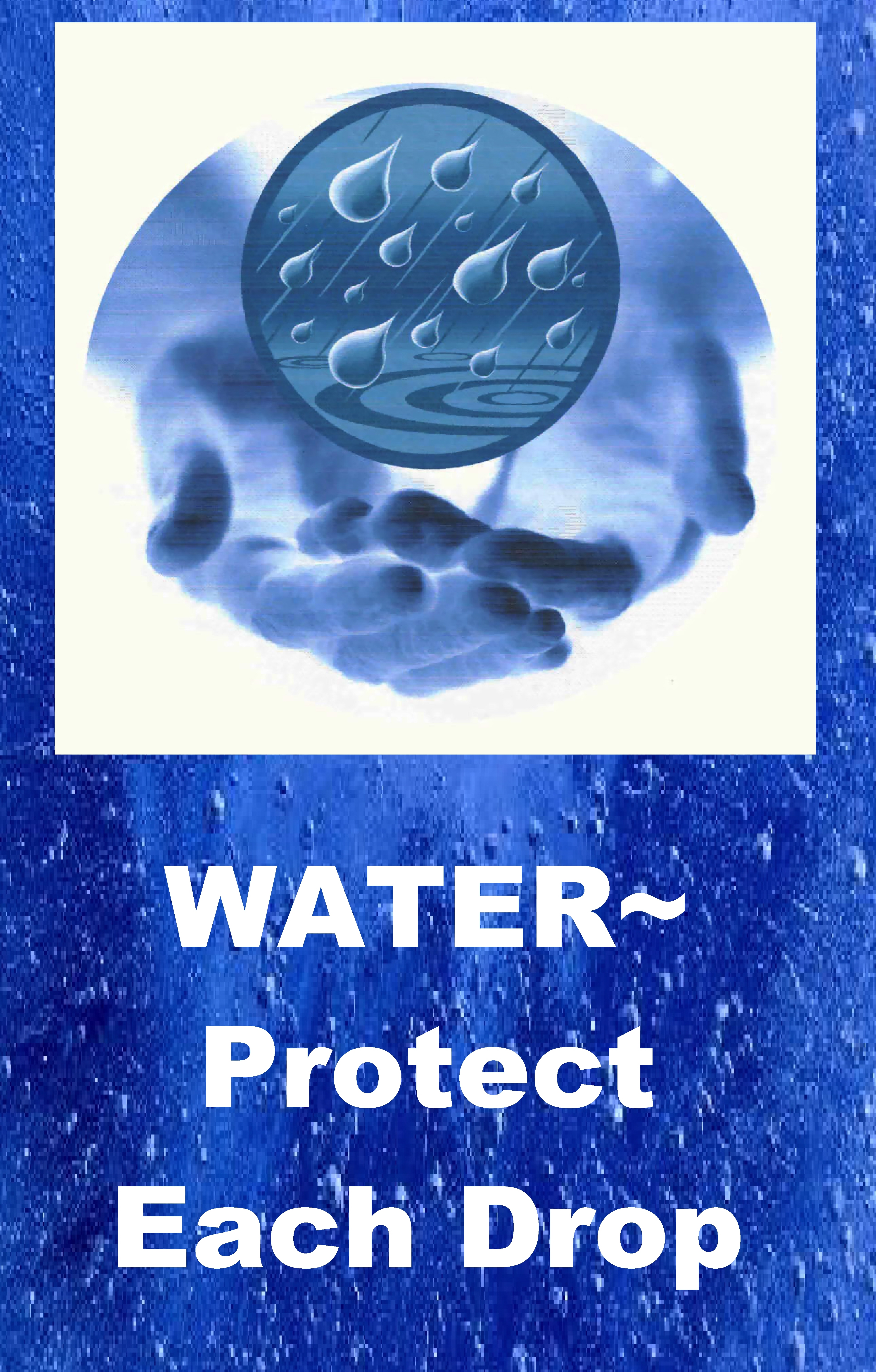Rain Water Harvesting is a 6000 year old ART!
Rainwater harvesting has seen a marked resurgence.
Archeological evidence attests to the capture of rainwater as far back as 4000 years ago and the concept of rainwater harvesting in China dates back 6000 years. In current times, Rainwater Harvesting is used as a viable and sustainable method of obtaining potable water in many areas of the world. In Central Texas, more than 400 full scale rainwater harvesting systems have been installed by professional companies, and more than 6000 rain barrels have been installed through the City of Austin’s incentive program in the past decade. Countless “do-it-yourselfers” have installed systems over the same time period, and many more are being installed, all seeking a sustainable, high-quality water source. (TWDB TMRH 2005)
Rainwater harvesting is also recognized as an important water conserving measure, and is best implemented in conjunction with other water efficiency measures outside the home. The State of Texas offers financial incentives for rainwater harvesting systems. Senate Bill 2 of the 77th Legislature exempts rainwater harvesting equipment from sales tax, and allows local governments to exempt rainwater harvesting systems from ad valorem (property) taxes. The depletion of groundwater sources, the poor quality of some groundwater, high tap fees for isolated properties, the flexibility of rainwater harvesting systems, and modern methods of treatment provide excellent reasons to harvest rainwater for domestic use. (TWDB TMRH 2005)
On the local level, the demand for Rainwater Harvesting Education has grown. Mr. John C. Kight, Rainwater Harvesting expert and presenter, has been presenting rainwater harvesting information in many workshops/seminars each month to local civic, social and business organizations and to the general public and receives more requests for his Rainwater Harvesting presentations every day. His Rainwater Harvesting Education Project will expand the capability to educate the public on the benefits and feasibility of Rainwater Harvesting Systems for public use, and with Mr. Kights’ assistance, will be able to reach a larger segment of the local population within our 10 county service area.
Rainwater Harvesting History by John Kight
Rainwater harvesting is certainly nothing new. Nomadic Indians, early settlers and wildlife depended on natural catch basins for part of their water supplies. Many rural homes depended on cisterns to store their water supplies of harvested rainwater.
The importance of rainwater harvesting systems began to fade when the ability to drill deep wells surfaced and windmills or powered pumps became available to provide groundwater on demand.
The rainwater harvesting systems of today are no different from the old days except we now have pre-filter first flush devices and good final filtration with ultra-violet treatment to eliminate all bacteria resulting in a high quality water source that is naturally pure and soft without any chemical additives.
In order to encourage the use of rainwater harvesting the State of Texas has been pro-active in it’s support.
- Proposition 2 passed in 1993 exempted any water conservation equipment used in non-residential buildings from property taxes.
- Senate Bill 2 passed in 2001 allowed the local taxing authorities to exempt all or part of the assessed value of property used for water conservation efforts.
- Senate Bill 2 also provided sales tax exemption on rainwater harvesting equipment.
- House Bill 645 passed in 2003 prevented implementing new covenants by Homeowner Associations which ban rainwater harvesting systems.
- House Bill 2430 passed in 2005 required the Texas Water Development Board to establish a Rainwater Harvesting Committee to develop a report titled “Rainwater Harvesting Potential and Guidelines for Texas”. This report is due to the Lieutenant Governor by December 2006
Rainwater Harvesting by John Kight
There is a special person here in Boerne who holds the preservation of our water resources dear to his heart. John Kight, an engineer and owner of a home water catchment system provides (free of cost) the latest information about the rain water harvesting process through his workshops at the Cibolo Nature Center.
Participants (who pay a small charge to the CNC) will recieve a unique opportunity to learn about the catchment system design from his detailed presentation and with materials distributed to help the homeowner get it done.
Kights home has no water well nor any outside water sources is in the Texas Hill Country near Boerne and it is a normal house like yours or mine. His rainwater catchment system comfortably supplies safe, clean, water for all his household and landscape needs.
Rainwater catchment systems accumulate and store rainwater which is then filtered to provide purified drinking water that can be used to water livestock, for irrigation, to refill aquifers and for every home use that you can think of.
Kight uses his system for his entire household and he teaches you through his workshops how to do that in your home also. All water systems in your home: toilets, washing, drinking, watering the garden and much more can use rainwater as their source.
Stay tuned to this page for more information on the benefits of rainwater harvesting, how to put it into your home and where to find resources. Mr. Kight has agreed to be the advisor of this page on these items so you know the information is good to go!!
Getting to know Mr. Kight:
Mr. John C. Kight, Retired as a director of Transportation Planning and Development after 35 years of service, is a former Kendall County Commissioner, project manager for the City of San Antonio, member of the Edwards Aquifer Protection Ordinance Committee, Engineering Consultant and currently is Director and Vice President of Cow Creek Groundwater Conservation District, Chairman of the Board of Trustees of the Hill Country Community MHMR Center, Member of the South Texas Regional Water Planning Group, Region L and is a member of the Kendall County Thoroughfare Planning Committee.
Mr. Kight has built a full rainwater harvesting system for potable and non-potable water use in his home (with no ground water well backup system) which has been providing all his family water needs for the past 7 years. Mr. Kight has been donating his time and expertise on Rainwater Harvesting Systems by volunteering as the presenter at rainwater harvesting workshops all over the Texas Hill Country. He is totally committed to the demonstration of the viability and cost effectiveness of rainwater harvesting systems as sustainable high quality alternate source of water.
Rainwater Harvesting WORKS!
RAINWATER HARVESTING EDUCATION PROGRAM
Since ancient times, civilizations have prospered or faltered in response to water availability. Early people knew that rain supported life and that drought brought death. Roughly, the same amount of water exists today as when it was first formed on the planet. However, our demand for water has increased over time. According to some water resource specialists, water usage has tripled since 1950.
Texas is the second largest and third most populous state in the United States supporting approximately 17 million people. As the state continues to prosper, the growing number of people will put a strain on the state’s existing ground and surface water. Bexar County alone has more than 1.5 million people and its population is expected to double over the next 50 years. Bexar and surrounding counties are one of the fastest growing areas in the state. In Texas current water demand is 75% of existing capacity, and in some basins, demand is approaching 100% of available supplies. On average, every American uses about 100 gallons of water per day. That makes daily water consumption in the U. S. alone, over 372 billion gallons per day. Even with proactive efforts, demand for water in Texas will eventually exceed existing water supplies.
With the increase in demand for a finite resource, our local Hill Country area, faces diverse water issues. How can we satisfy human needs while protecting the ecological integrity of natural systems? How can populations balance their need to use water with their responsibility for its quality and availability? The resolution of these issues depends on a populace sensitive to and knowledgeable of water and water resources. Education provides one of the best approaches to ensuring responsible behavior toward water.
Rainwater harvesting is an ancient technique enjoying a revival in popularity due to the inherent quality of the rainwater and interest in reducing consumption of treated water. Rainwater is valued for its purity and softness. It has nearly neutral pH and is free from disinfection by-products, salts, minerals and other natural and man-made contaminants. Plants thrive under irrigation with stored rainwater. Appliances last longer when free from corrosive or scale effects of hard water. Users with potable systems prefer the superior taste and cleansing properties of rainwater. (TWDB TXRH 2005)
Advantages and benefits of rainwater harvesting are numerous (Krishna, 2003)
- The water is free; the only cost is for collection and use,
- The end use of harvested water is located close to the source, eliminating the need for complex and costly distribution systems,
- Rainwater provides a water source when groundwater is unacceptable for unavailable or it can augment limited ground water supplies,
- The zero hardness of rainwater helps prevent scale on appliances extending their use; rainwater eliminates the need for a water softener and the salts added during the softening process,
- Rainwater is sodium-free, important for persons on low-sodium diets,
- Rainwater is superior for landscape irrigation,
- Rainwater harvesting reduces flow to storm water drains, lessoning the impact on erosion and also reduces non-point source pollution,
- Rainwater harvesting helps utilities reduce the summer demand peak and delay expansion of existing water treatment plants,
- Rainwater harvesting reduces consumers’ utility bills.
Rainwater harvesting, in its essence, is the collection, conveyance and storage of rainwater. The scope, method, technologies, system complexity, purpose and end uses vary from rain barrels for garden irrigation in urban areas to large scale collection of rainwater for all domestic uses. Harvested rainwater also helps Texas communities close the gap between supply and demand projected by the Texas Water Development Board (TWDB) as the state’s population nearly doubles between 2000 and 2050. (TWDB TXRH 2005)
The depletion of groundwater sources, the poor quality of some groundwater, high tap fees for isolated properties, the flexibility of rainwater harvesting systems, and modern methods of treatment provide excellent reasons to harvest rainwater for domestic use.
Resources:
Presented by John Kight and MASCAT Consultants of Boerne Texas.
TWDB = Texas Water Development Board
Harvesting Conference, Austin, TX.
Krishna, Hari J., 2003, An overview of rainwater harvesting systems
Watershed Ptotection: Water Protect Each Drop is a
program of Alamo RCD Area Inc.


